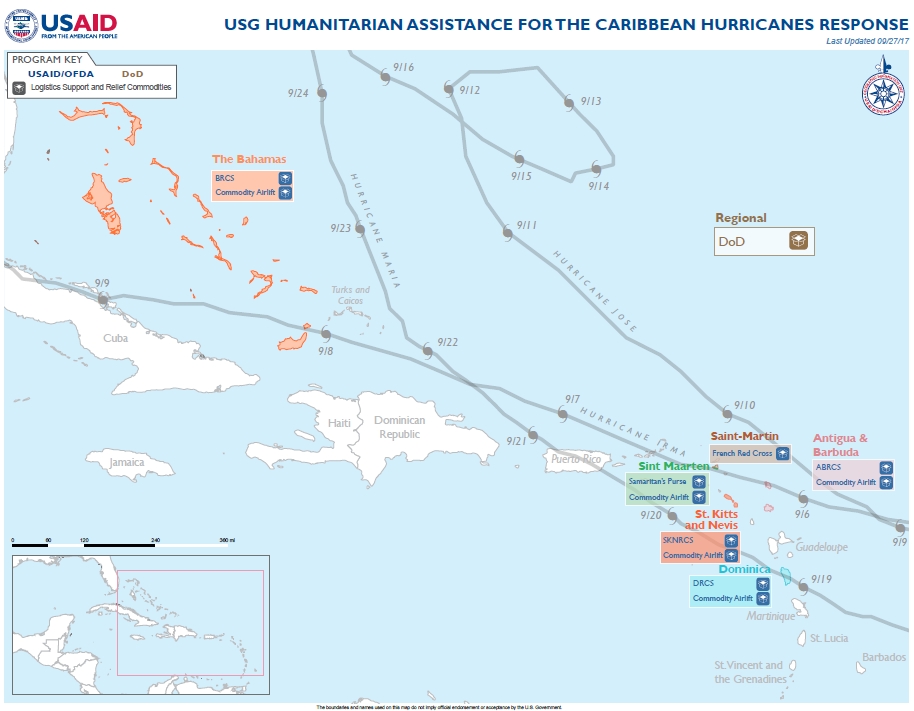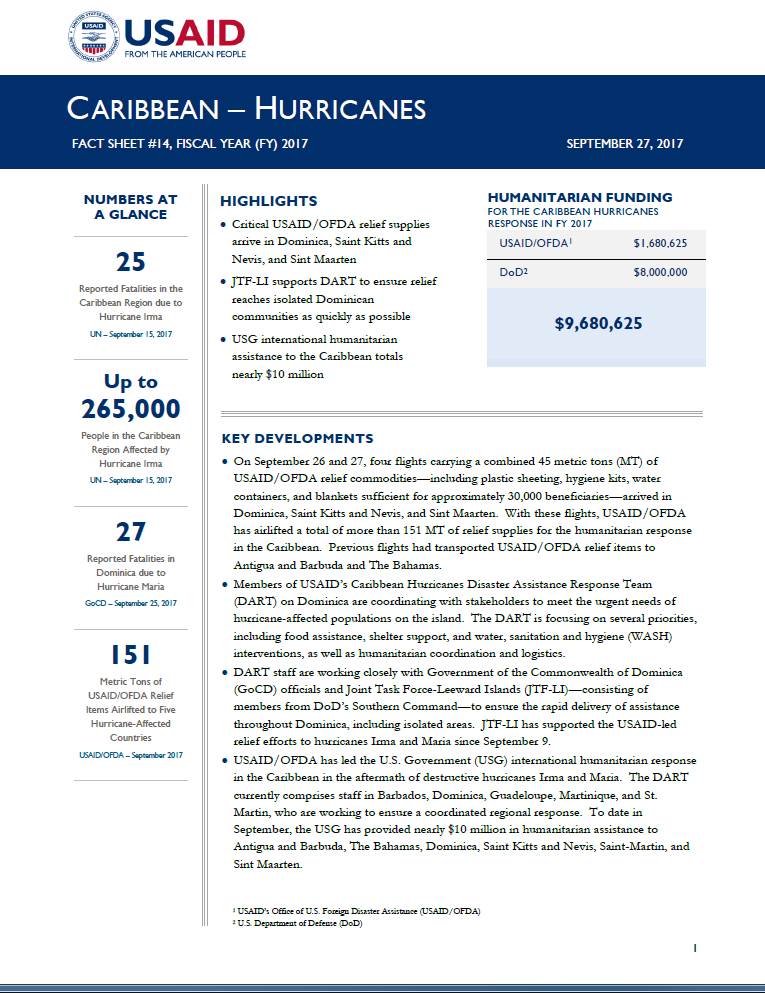Speeches Shim
September 27, 2017
Highlights
- Critical USAID/OFDA relief supplies arrive in Dominica, Saint Kitts and Nevis, and Sint Maarten.
- JTF-LI supports DART to ensure relief reaches isolated Dominican communities as quickly as possible.
- USG international humanitarian assistance to the Caribbean totals nearly $10 million.
Key Developments
Caribbean Hurricanes - Map #14 ![]() (pdf - 287k)
(pdf - 287k)
Numbers At A Glance
25
Up to 265,000
27
151
Humanitarian Funding
For the Caribbean Hurricanes Response in FY 2017
| USAID/OFDA | $1,680,625 |
| DoD | $8,000,000 |
| Total | $9,680,625 |
Caribbean Hurricanes - Fact Sheet #14 ![]() (pdf - 197k)
(pdf - 197k)
On September 26 and 27, four flights carrying a combined 45 metric tons (MT) of USAID/OFDA relief commodities—including plastic sheeting, hygiene kits, water containers, and blankets sufficient for approximately 30,000 beneficiaries—arrived in Dominica, Saint Kitts and Nevis, and Sint Maarten. With these flights, USAID/OFDA has airlifted a total of more than 151 MT of relief supplies for the humanitarian response in the Caribbean. Previous flights had transported USAID/OFDA relief items to Antigua and Barbuda and The Bahamas.
Members of USAID’s Caribbean Hurricanes Disaster Assistance Response Team (DART) on Dominica are coordinating with stakeholders to meet the urgent needs of hurricane-affected populations on the island. The DART is focusing on several priorities, including food assistance, shelter support, and water, sanitation and hygiene (WASH) interventions, as well as humanitarian coordination and logistics.
DART staff are working closely with Government of the Commonwealth of Dominica (GoCD) officials and Joint Task Force-Leeward Islands (JTF-LI)—consisting of members from DoD’s Southern Command—to ensure the rapid delivery of assistance throughout Dominica, including isolated areas. JTF-LI has supported the USAID-led relief efforts to hurricanes Irma and Maria since September 9.
USAID/OFDA has led the U.S. Government (USG) international humanitarian response in the Caribbean in the aftermath of destructive hurricanes Irma and Maria. The DART currently comprises staff in Barbados, Dominica, Guadeloupe, Martinique, and St. Martin, who are working to ensure a coordinated regional response. To date in September, the USG has provided nearly $10 million in humanitarian assistance to Antigua and Barbuda, The Bahamas, Dominica, Saint Kitts and Nevis, Saint-Martin, and Sint Maarten.
DOMINICA
As of September 25, Hurricane Maria had caused at least 27 fatalities on the island of Dominica and left at least 27 people missing, according to the GoCD. The Category 5 hurricane affected the entirety of the island, damaged nearly all roofs, destroyed crops and agricultural infrastructure, and disrupted power and water supplies island-wide.
Residents of Dominica report safe drinking water and materials to mend roofs as their primary needs, according to the DART and other humanitarian stakeholders on the ground. The DART’s shelter and settlements technical advisor has echoed the critical need for roofing materials on the island, noting that most houses and other buildings remain habitable but require roof repairs.
As part of WASH assessments, the DART’s WASH technical advisor met with the Dominica Red Cross Society (DRCS) and local utility Dominica Water and Sewerage Company Limited (DOWASCO) on September 25 and visited accessible areas of Dominica on September 26. According to the technical advisor’s observations, most communities in rural areas continue to rely on natural springs and rivers as their main water sources, as they did prior to the passage of Hurricane Maria. However, residents now lack the means or access to purchase propane supplies for boiling water, leading to concerns regarding the quality of drinking water. The DART and other humanitarian actors are working to determine appropriate solutions to ensure access to safe drinking water for Dominica residents.
Two flights carrying USAID/OFDA emergency relief commodities reached Dominica on September 26 and 27. The flights transported 2,400 water containers, 1,600 blankets, 1,000 hygiene kits, and 400 rolls of plastic sheeting from USAID/OFDA stockpiles in Miami, Florida, to the hard-hit Caribbean island. The plastic sheeting is expected to benefit an estimated 20,000 hurricane-affected people, allowing them to commence shelter repairs, while the other relief items are each sufficient to assist approximately 4,000 to 5,000 beneficiaries. Due to the ongoing road access constraints, the DART has requested JTF-LI support to help convey the relief commodities as quickly as possible to priority locations identified by the GoCD.
USAID/OFDA also contributed its emergency relief commodities pre-positioned in the region toward the humanitarian response on Dominica. On September 26, in coordination with the GoCD and other responders, USAID/OFDA water containers, hygiene kits, and kitchen sets were distributed to 13 shelters in Roseau and neighboring urban areas in St. George and St. Paul parishes. In total, the day’s distributions included 900 water containers for 2,250 people, 400 hygiene kits for 2,000 people, and 105 kitchen sets for 525 people. USAID/OFDA originally delivered the relief items to the island of Antigua to meet the immediate needs of disaster-affected people on Antigua and Barbuda after Hurricane Irma and to replenish stockpiles for future disasters. Following Hurricane Maria’s destruction, the pre-positioned USAID/OFDA supplies became available for use on Dominica.
The UN World Food Program (WFP) has delivered 10 MT of high-energy biscuits (HEBs) to Dominica from its pre-positioned stocks in Antigua. Since September 25, in coordination with the GoCD, WFP has been distributing the HEBs to communities in need via helicopter and boat with the support of military forces from the governments of Canada and the Kingdom of the Netherlands. Earlier in September, following the passage of Hurricane Irma, WFP had moved part of its HEB stocks from Haiti to a regional hub in Antigua in preparation for emergency food needs in the Caribbean. USAID Office of Food for Peace (USAID/FFP) funding has supported WFP’s HEB pre-positioning and distribution efforts.
With $100,000 in initial USAID/OFDA funding, DRCS plans to procure and distribute additional relief items, including solar lamps, mattresses, and bedding, to address the needs of an estimated 5,000 hurricane-affected households on Dominica. DRCS will also contribute to community clean-up efforts, register beneficiaries for distributions, and conduct post-distribution evaluations.
SAINT KITTS AND NEVIS
A shipment of 100 rolls of USAID/OFDA plastic sheeting—sufficient for up to 5,000 people—arrived on Saint Kitts and Nevis on September 27. USAID/OFDA is providing the sheeting to the Government of Saint Kitts and Nevis National Emergency Management Agency for onward distribution to hurricane-affected populations. USAID/OFDA partner the Saint Kitts and Nevis Red Cross Society (SKNRCS) is working to identify the households most urgently in need of assistance to receive the plastic sheeting.
Through an initial $50,000 in funding, USAID/OFDA is supporting SKNRCS to procure and distribute building materials, such as galvanized sheeting, tar paper, and nails, as well as hygiene supplies for adults and children. The assistance is expected to benefit up to 4,000 hurricane-affected households.
ST. MARTIN
On St. Martin, most businesses, including banks, stores, gas stations, and restaurants, in both Saint-Martin and Sint Maarten have resumed normal operations as of September 27, according to DART staff. Residents have also reported the restoration of essential services, including water and electricity, in many neighborhoods in recent days.
Since the passage of Hurricane Irma, USAID and DoD have provided humanitarian assistance on St. Martin to complement relief activities led by local officials in Saint-Martin and Sint Maarten, as well as the governments of France and the Kingdom of the Netherlands. On September 26, a flight carrying 100 rolls of USAID/OFDA plastic sheeting arrived in Sint Maarten. USAID/OFDA is providing the sheeting to the Government of Sint Maarten to assist up to 5,000 people with emergency shelter support needs.
With a $100,000 initial contribution, USAID/OFDA is supporting Samaritan’s Purse to provide water containers to hurricane-affected households in Sint Maarten. On September 25 and 26, the organization distributed a combined 3,630 water containers to Sint Maarten residents.
In coordination with French and Saint-Martin authorities, the DART requested that the JTF-LI establish and operate eight lightweight desalination units in the French overseas collectivity to address residents’ need for potable water in the aftermath of Hurricane Irma. The JTF-LI set up four units each at two water-production sites. Between September 15 and 27, the sites generated approximately 83,020 gallons, or 314,260 liters, of water for household use.
USAID/OFDA is providing an initial $100,000 to the French Red Cross to support the procurement and distribution of water containers in Saint-Martin. The DART reports that the French Red Cross, in coordination with local authorities, is distributing emergency relief items at six locations in Saint-Martin. The organization is also conducting information campaigns across Saint-Martin to notify residents of health services and the locations and times of humanitarian distributions in the collectivity, as well as the government benefits available to them as French citizens.
INTERNATIONAL RESPONSE
On September 26, the European Commission’s Directorate-General for Humanitarian Aid and Civil Protection (ECHO) announced a contribution of €250,000, or approximately $293,600, in emergency assistance to Dominica. ECHO’s funding will support the provision of food and water assistance, construction materials, and fuel, as well as logistical support to reach isolated communities.
CONTEXT
During successive weeks in September, hurricanes Irma, Jose, and Maria tracked through the Caribbean. The storms, particularly Irma and Maria, brought destructive winds, heavy rainfall, and dangerous storm surge to affected islands, leading to at least 52 fatalities and causing significant infrastructure damage across the region.
On September 6, U.S. Chargé d’Affaires, a.i., Lisa A. Johnson issued a disaster declaration in response to the anticipated effects of Hurricane Irma in The Bahamas, and on September 7, U.S. Ambassador to Barbados and the Eastern Caribbean Linda S. Taglialatela issued a disaster declaration in response to Hurricane Irma and the anticipated effects of Hurricane Jose in Antigua and Barbuda. In response, USAID/OFDA contributed an initial $100,000 each to the Bahamas Red Cross Society and the Antigua and Barbuda Red Cross Society.
On September 7, USAID activated a regional DART and stood up a Washington, D.C.-based Response Management Team to coordinate the USG’s humanitarian response to the hurricanes.
On September 9, U.S. Embassy in Paris Chargé d’Affaires D. Brent Hardt issued a disaster declaration for the French Saint-Martin, and on September 10, U.S. Embassy in The Hague Chargé d’Affaires Shawn Crowley declared a disaster for Sint Maarten due to the effects of Hurricane Irma and anticipated effects of Hurricane Jose. In response, USAID/OFDA contributed an initial $100,000 each for activities in Saint-Martin and Sint Maarten.
Following the passage of Hurricane Maria, Ambassador Taglialatela issued disaster declarations for Dominica and Saint Kitts and Nevis due to the storm impacts. In response, USAID/OFDA provided an initial $100,000 to Dominica and $50,000 to Saint Kitts and Nevis to address priority needs.
PUBLIC DONATION INFORMATION
The most effective way people can assist relief efforts is by making cash contributions to humanitarian organizations that are conducting relief operations. A list of humanitarian organizations that are accepting cash donations for disaster responses around the world can be found at www.interaction.org.
USAID encourages cash donations because they allow aid professionals to procure the exact items needed (often in the affected region); reduce the burden on scarce resources (such as transportation routes, staff time, and warehouse space); can be transferred very quickly and without transportation costs; support the economy of the disaster-stricken region; and ensure culturally, dietary, and environmentally appropriate assistance.
More information can be found at: USAID Center for International Disaster Information: www.cidi.org or +1.202.661.7710. Information on relief activities of the humanitarian community can be found at www.reliefweb.int.



Comment
Make a general inquiry or suggest an improvement.